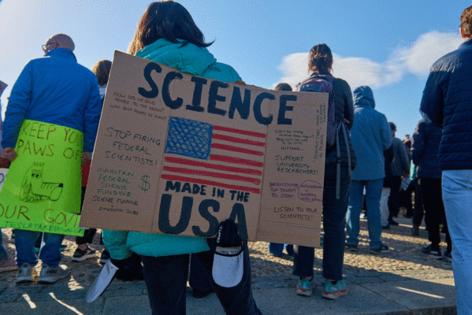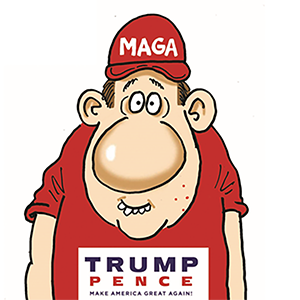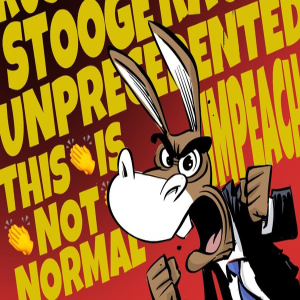Lisa Jarvis: Politicizing scientific research comes with a hefty price
Published in Op Eds
The Trump administration, seemingly determined to dismantle the National Institutes of Health, continues to devise new and insidious ways to politicize what has long been considered the crown jewel of U.S. research.
The latest move? An effort to codify political oversight of the agency’s operations and impose abrupt and far-reaching changes to how research funding is allocated.
That’s left academic researchers — already at the mercy of a mercurial administration — in a constant state of uncertainty, wondering when their work might be targeted next. It’s also shrinking the scope of science the NIH is willing to support and making the U.S. a far less attractive place for pursuing biomedical innovation. The long-term consequence? A slowdown in discoveries that could meaningfully improve patients’ lives.
Since January, the Trump administration has repeatedly blindsided universities. More than 80% of the NIH’s $48 billion budget supports academic research — funding distributed through a rigorous, well-established system — one that Office of Budget and Management Director Russell Vought appears intent on upending.
“There’s just a lot in limbo on every possible level,” says Carrie Wolinetz, a former senior NIH official who now works at the government relations firm Lewis-Burke.
The pain for academia began just days after Trump took office. Funds for grants to support researchers at universities, hospitals and nonprofits were abruptly frozen. Weeks later, overhead costs — negotiated fees that pay for the infrastructure supporting labs around the country — were slashed. Researchers — first a few dozen, then hundreds — also began receiving notices that their grants had been canceled. Trump’s political crackdowns eventually led to universities like Columbia, Harvard, Northwestern and UCLA losing research funding entirely.
The courts and Congress have consistently pushed back against these maneuvers and some schools have brokered deals with the Trump administration. That reopened funding streams at some universities and for certain grants, but the future of broad segments of research remains uncertain as the fiscal year draws to a close. “There’s a bunch of money caught up in litigation, almost like Schrödinger’s cat: it’s neither spent nor unspent,” Wolinetz says. She and others remain unclear on what happens to those funds when the calendar flips to October.
Amid all this, the process of awarding new grants slowed to a glacial pace. Researchers waiting to hear back about projects that, in the past, would have sailed through the rigorous NIH process, found themselves in an anxiety-inducing holding pattern. Would the money ever come through?
The source of the holdup is a quiet internal policy requiring projects to undergo not just scientific review, but political scrutiny. No longer can a grant receive the green light unless someone, somewhere, combs through it to be sure no money would be spent in defiance of Trump’s many executive orders — particularly those related to diversity, equity and inclusion, as well as foreign influence and gender-related policies.
That prolonged slowdown has now culminated in a frantic push to spend the $48 billion that Congress allocated to the NIH before the fiscal year ends on Sept. 30.
NIH staff have their work cut out for them. Between the grant terminations and the delay in issuing new ones, billions of dollars in allocated money remains unspent. According to an analysis by Jeremy Berg, a former director of an NIH institute, about $4.25 billion less had been committed by the end of July than had been awarded by that same point in 2024.
The goal of these political reviews, of course, is to weed out “offending” grants. But it also allows Vought to claw back money that Congress allocated to the agency: if the NIH can’t spend its full budget by Sept. 30, the remaining funds return to the U.S. Treasury.
That struggle, meanwhile, could become a recurring event. Earlier this month, Trump issued an executive order on federal grantmaking that attempts to codify this political review process under the guise of preventing wasteful spending. The order also goes a step further, allowing grants to be terminated “for convenience.”
Such measures raise the specter that any research crossing the wrong political line is at risk, making it even more difficult for anyone supported by the NIH to plan for the future. As Berg puts it, no matter how good the idea or how famous the researcher, “you’re just some politician’s whim away from having it all come apart.”
Meanwhile, another quiet change could mean far less science will be funded in the coming years. A new policy laid out last month directs the NIH to change how grants are funded — allocating all the money for a multi-year grant at once instead of spreading it across multiple years. That means that instead of being able to afford, say, five $1 million five-year projects, the NIH can now only pay for one.
That’s an approach worth considering, but implementing it abruptly is wildly irresponsible and will have a serious impact on both individual researchers and the scope of science funded in the U.S. The National Cancer Institute, for example, recently said the policy means it would only be able to fund around one in 25 grants, compared to just under one in 10 previously. That is already affecting even well-established cancer researchers, who tell me that grants previously rated among the top applications have been rejected because of the shift.
They can reapply, of course, but at the minimum it will significantly delay scientific progress that could directly affect patients. One rejected, highly-rated grant, for example, explores a new way to improve efficacy and lessen the side effects of chemotherapy.
Congress continues to send a clear message that NIH shouldn’t be meddled with. Members on both sides of the aisle protested Trump’s early attacks on the agency, which is a source of tremendous economic prosperity for local communities. And when the Trump administration asked for a 40% cut in the NIH budget for 2026, the Senate responded with a $400 million increase over the current $48 billion.
That consistent funding is critical — yet it’s also no longer a sufficient solution. The Trump administration’s efforts to wrest control of the U.S. research enterprise must be addressed, too — or we will spend decades trying to rebuild what is lost.
_____
This column reflects the personal views of the author and does not necessarily reflect the opinion of the editorial board or Bloomberg LP and its owners.
Lisa Jarvis is a Bloomberg Opinion columnist covering biotech, health care and the pharmaceutical industry. Previously, she was executive editor of Chemical & Engineering News.
_____
©2025 Bloomberg L.P. Visit bloomberg.com/opinion. Distributed by Tribune Content Agency, LLC.
























































Comments